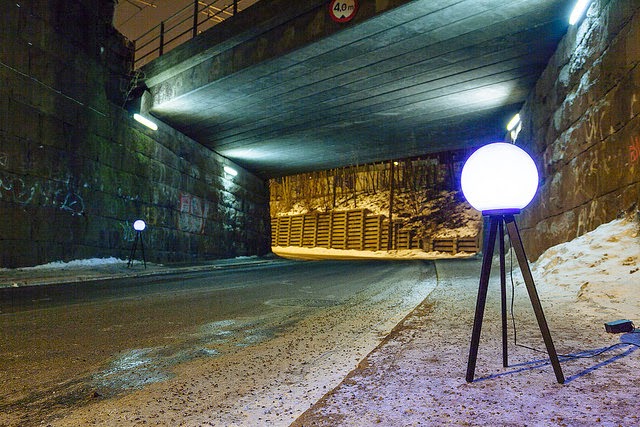Via BLDGBLOG
-----
Immaterials: Satellite Lamps from Satellite Lamps on Vimeo.
An interesting new project called Satellite Lamps, by Einar Sneve Martinussen, Jørn Knutsen, and Timo Arnall, attempts to visualize the ever-drifting, never exactly accurate workings of GPS.
As the above video shows, the project uses "a set of lamps that contain GPS receivers, that change brightness according to the accuracy of received GPS signals. When we photograph them in timelapse, they reveal how the accuracy changes over time."
You're basically watching the indirect effects of signal drift, transformed here into ambient mood lighting that acts secondarily as a graph of celestial geography.

[Image: From Satellite Lamps].
In what the group calls a "selective history of how a piece of the Space Program has ended up in our pockets," they explain that the everyday reception of signals coming down from the constellation of GPS satellites is always subject to temporary errors, inaccuracies, and misalignments; this can be seen easily enough by glancing at nothing more than your own physical location, as mapped on your cell phone.
They also point to an interesting observation, made by artist James Bridle, that "if you leave a running app such as Nike+ or Runkeeper on your bedside table while you sleep at night, you will wake up to see that the app reports that you ran a significant distance, without doing anything. This, we speculated, is due to the way in which these apps are recording the GPS inaccuracies and counting these as actual, physical movements. In reality, these odd asymmetrical star-shaped tracks offer a map of the shifts of the phone attempting to locate itself."
This ghostly movement is not "real" in any spatial or geographic sense, but it nonetheless leaves digital tracks in our information profiles, like phantom trips being taken by our data-shadows in secret.

[Image: From Satellite Lamps].
So why not visualize this ongoing slippage—these minor tectonics events taking place inside the tools of geography—in a different form, not with, say, an iPhone scooting around all over your neighborhood at night, trying to keep up with the haunted midnight fugues of an errant running app, but with something stationary, something all the more uncanny for the invisible movements that seem to pass through it like an aurora?
This, then, is the point of Satellite Lamps, which flicker and dim to help reveal the invisible glitches in earth-to-satellite coordination, paradoxically unmoving chandeliers that shine in a chiaroscuro of side-effects leaking in from a parallel world.

[Image: From Satellite Lamps].
In any case, the project is voluminously explained and documented. Considering reading about GPS itself, about the team's strategy for giving visual form to invisible information, and, finally, about the physical realization of the lamps.



